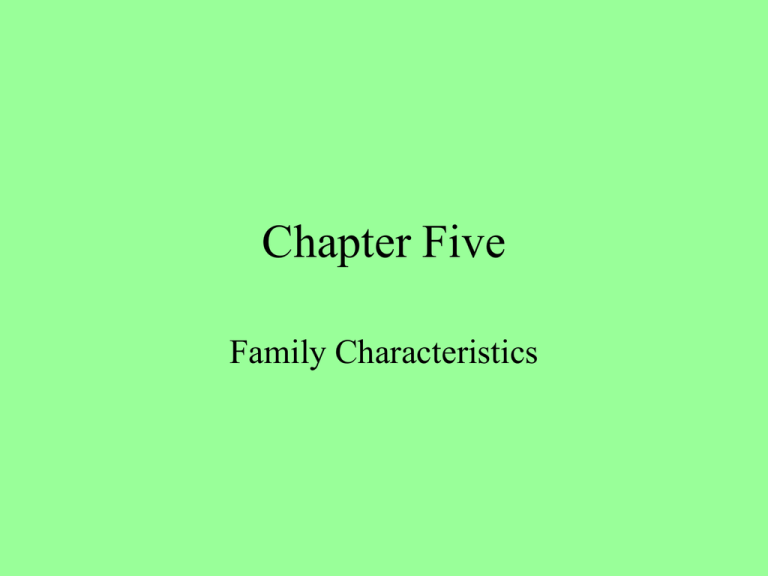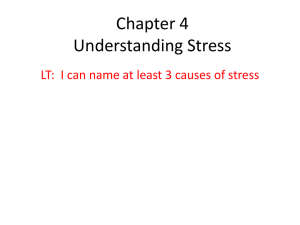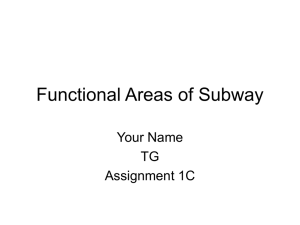Families #2 Family Characteristics
advertisement

Chapter Five Family Characteristics Family Systems • No individual can be understood without looking at how he or she fits into the whole of the family. • Families need both rules for structure and rules for change. • Interaction of the family with the school, community, extended family and friends is essential to the life of the nuclear family. Typical Family Life Cycle 1. 2. 3. 4. 5. 6. Newly married couple Families with young children Child rearing families Families with adolescents Families launching children Families in later life Lambie & Daniels-Mohring (1993) Newly Married Couple • Primary theme: attachments • Primary tasks: realignment of relationships with friends and family to include spouse and spouse’s family; commitment; goal sharing • Stressors: work-family, balancing changes with extended family, dealing with in-laws, developing dual career goals Families with Young Children • Primary theme: developing strategies for getting things done • Primary tasks: realignment of marital system to include children, develop parenting style • Stressors: financial strains, making decisions about both careers and child care options Child Rearing Families • Primary theme: bringing others into the family boundaries, consolidating accomplishments of family members • Primary tasks: establishing sibling roles, division of family responsibilities • Stressors: intrafamily strains, dealing with involvement in school activities and families of children’s peer group Families with Adolescents • Primary theme: decentralization, loosening boundaries • Primary tasks: managing children’s increasing independence, midlife career and marital issues, increasing flexibility of roles • Stressors: financial-handling demands of feeding, clothing and entertaining adolescents Families Launching Children • Primary theme: differentiation, detachment • Primary tasks: Negotiating to become a couple again, renegotiating roles with adult children • Stessors: Financial strains: dealing with paying for college, wedding, or helping children begin their own nuclear families Families in Later Life • Primary themes: letting go, dissolving ties • Primary tasks: Redefinition of roles between aging spouses; dealing with the death of friends and family • Stressors: financial strains: planning for the loss of income following retirement, paying for health care costs Areas for Major Life Problems Families with Special Needs Go Through the Same Family Life Cycle but Often Face Additional Issues 1. Myths 2. Pile-up 3. Added financial burdens Stages of Grief • • • • • • Shock Denial Anger Bargaining Depression Acceptance Individual Variations • People do not experience each of these feelings in a set order with resolve or closure at the end – Grief is idiosyncratic – People may vacillate between stages at various points in their lives – People may “regress” to earlier stages Characteristics of Coping 1. Ability to identify the stressor. 2. Viewing the situation as a family problem rather than the problem of one member. 3. Adopting a solution-oriented approach rather than blaming. 4. Showing tolerance for other family members. Characteristics of Coping 5. Commitment/ affection for other family members 6. Evidence of high family cohesion. 7. Evidence of considerable role flexibility. 8. Open and clear communication. 9. Use of resources in and outside family. 10. Lack of physical violence. 11. Lack of substance abuse. Figley and McCubbin (1983) Survival During Hard Times 1. 2. 3. 4. Know when you are in hard times. Face hard times together. Take your time. Ask for outside help when your family is stuck. McFadden & Doub (1983) Chapter Six Family Interactions Nontraditional Families 1. Separation and divorce a. Impact on children b. Impact on parents c. Financial problems d. Family management problems e. Personal problems Nontraditional Families 2. Blended families a. Clarifying lines of authority b. Financial issues c. Loyalty issues d. Needs for effective communication 3. Other nontraditional families a. Grandparents or other extended family b. Adoptive c. Same sex Role of Educational Conferencer in Working with Nontraditional Families 1. Be aware of priority concerns 2. Be able to suggest resources and services 3. Be aware of severe time, energy and financial restrictions 4. Include noncustodial parents in conferences and programs 5. Listen Role of Educational Conferencer in Working with Nontraditional Families 6. Become familiar with your own family-related values 7. Be able to apprise parents and family members of potential impact of factors on family structure 8. Aid parents in becoming effective in various roles 9. Anticipate atypical behavior in parents and children experiencing turmoil and change Multicultural Issues 1. 2. 3. 4. 5. Over-representation in special classes Assessment Suspensions/ zero tolerance Poverty Awareness and acceptance of cultural diversity and individual differences 6. Likenesses vs differences Discussion: School and Culture 1. In what ways do middle-class teachers, reflecting the school’s values, single out for criticism differences in children’s behavior and values? 2. What changes should take place for the structure of the school to be flexible enough to accommodate the diverse abilities and interests of a heterogeneous student body?




